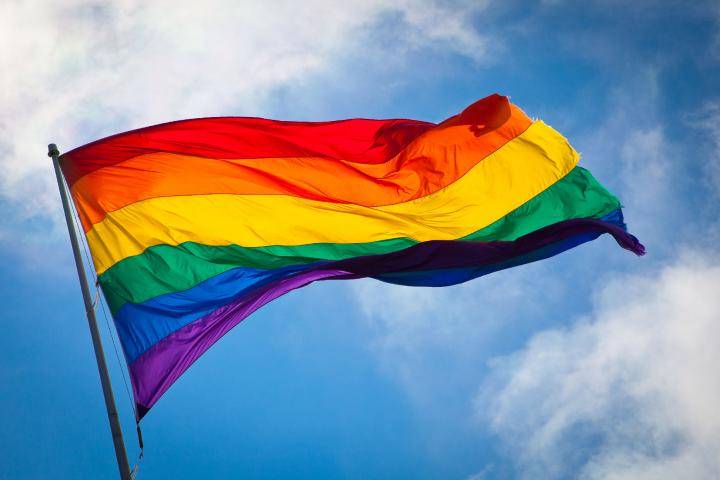“Homosexuality has never been considered a crime in Hindu culture. In fact, Lord Ayyappa was born of Hari-Hara (Vishnu & Shiva). It is not a crime in any Smriti. Everyone has male & female elements. According to their dominance, tendencies show up & may change. Nobody should face discrimination because of their sexual preferences. To be branded a criminal for this is absurd.” – H.H. Sri Sri Ravi Shankar
One of Hinduism’s core teachings is that every being is Divine or a reflection of Divine qualities, regardless of one’s outer attributes. Aside from the humanitarian imperative to offer equal treatment to all, the Hindu American Foundation (HAF) believes that this and other fundamental and ancient Hindu teachings may allow Hindus to more openly embrace LGBT rights and marriage equality. In this paper, we seek to elucidate these aspects and, at the same time, elaborate on the legislative history of LGBT rights in India.
A Hindu Approach to LGBT rights
While the equal religio-spiritual potential of all individuals is key to understanding a Hindu basis for dignity for LGBT persons, so too is the way in which Hindu religious texts and teachings are approached. There are two different sets of Hindu religious texts: (i) the Sruti, which are scriptures like the Vedas and Upanishads that are believed to enunciate eternal truths; and (ii) the Smriti, which are books like the Manu Smriti and Yagnavalkya Smriti that detail socio-religious laws and customs bound by time, place, and circumstance. Smritis, by their very nature, are time bound and subject to change, and such bifurcation between eternal truths and socio-religious customs underpins HAF’s approach to LGBT rights.
Hindu sruti texts don’t address sexual orientation at all or indeed social issues in general. They state that every being is an eternal soul, or atman, incarnate, and that the ultimate goal of life is moksha, or freedom from the cycle of birth and death. Moksha is attained by one’s real self, or atman, which is distinct from one’s physical body and personality (ego), as well as outer attributes such as race, caste, gender, and sexual orientation.
Progress towards moksha comes through yogic spiritual practices (selfless service, loving devotion of God, simple living, prayer and meditation, etc.), and its attainment implies, amongst other things, completely transcending material desires and impulses, including sexual ones. To put it provocatively, an LGBT person who lives selflessly and has mastered his or her impulses (sexual or otherwise) is actually closer to moksha than a non-LGBT person who is a slave to desires. Thus, Hindus cannot point to anything in the sruti texts that supports treating LGBT persons as being inferior to non-LGBT persons, let alone supports their persecution.
The smritis, some of which are socio-religious codes from particular eras in Hindu history have imbibed the perspective of the srutis and have never advocated broad-based, harsh punishments for homosexuality. Professor Arvind Sharma, a Hindu academic1 at McGill University in Montreal, Canada, states in his essay on Homosexuality and Hinduism: “It appears from the foregoing account that, save for the emphasis on renunciation, Hinduism is a sex-positive religion in relation to all the other…ends of human life….”
The Manusmriti, which has come under considerable criticism from many quarters for its regressive pronouncements on caste, does express mild opposition to homosexuality, but prescribes such quixotic punishments as bathing in public with one’s clothes on.2 The most stringent punishment, that of cutting off two fingers (or shaving the head and riding a donkey), is prescribed for an older woman who has a relationship with a young virgin.3 But the concern here is on virginity, not homosexuality. The exact same punishment of cutting off two fingers (plus a fine of 600 panas of gold) is prescribed for a man who violates a virgin woman just a few verses earlier4. Notably, there is also no such punishment in the case of two older women. Prof. Arvind Sharma also points out that if traditional Balinese culture is taken to represent an older and at least a trans-Indian form of Hinduism, the Hindu attitude to homosexuality is one of mild amusement bordering on indifference.5
The Hindu epics such as the Mahabharata mention several characters who demonstrate a range of sexual orientations and gender identities, including Shikhandi, Chitrangada (wife of Arjuna and mother of Babruvahana), and Brihannala. None of these characters are discriminated against because of sexual orientation or gender identity. Rather, they are all treated with respect, and judged by their abilities rather than their sexuality. Several other ancient works such as the Arthashastra (a treatise on politics and economics) and the Kama sutra have numerous mentions of LGBT individuals in various professions free from any persecution. And stories such as Lord Ayyappa (born to Shiva and Vishnu as Mohini) indicate the mystical and subtle approach that Hinduism adopts towards matters of gender in varying contexts.
Thus, not only do the srutis lay absolutely no bar on moksha for LGBT persons, the codes of conduct of ancient India as well as other smriti texts seem to have largely ignored the LGBT phenomenon, rather than persecute them; or positively focused on their abilities, rather than their sexuality or gender.
What about marriage as a religious rite?
India actually has a centuries history of wedding rites for hijras, transgender people who have long been recognized in Hindu texts and society, and more recently, the Indian Supreme Court, as third gender. And in recent years, some Hindu priests and same-sex couples in the U.S. and around the world have adapted and found acceptance in traditional Hindu wedding rituals. The Saptapadi is a key marriage ritual that enunciates seven vows of an ideal Hindu marriage. The vows remind every couple about the true purpose of a life partnership: (i) nourishing one another; (ii) growing strong together; (iii) fulfilling spiritual obligations; (iv) working towards happiness and fulfillment through mutual respect; (v) working for the welfare of all living beings through raising virtuous children; (vi) praying for bountiful seasons which they may go through together, just as they would share their joys and sorrows; and (vii) praying for a life of understanding, loyalty, and companionship not only for themselves, but also for universal peace. The four circumambulations around the ceremonial fire, which is also a part of most Hindu weddings, symbolize the couple’s commitment, both together and as individuals, to the four pursuits in life: dharma (right action), artha (prosperity), kama (material pleasure), and moksha.
While the government may regulate the legal right to marriage, marriage as a religious rite obviously falls within the realm of religious freedom. HAF firmly holds that sampradayas, temples, religious leaders, and priests have an inalienable right to define marriage in conformity with their traditions, as they continue to interpret and reinterpret them over time. But because Hinduism has no central authority that controls theology, and values a tradition of interpretation according to time and space by those qualified and with spiritual competency (adhikara), different groups and individuals may move (or not move) at a varying pace on a religious sanction of a rite as fundamental as marriage.
As religious rites of same-sex marriage continue to evolve (or in some cases, not), HAF agrees with the U.S. Supreme Court that governments should not discriminate in the matter of marriage as a legal right or social contract. HAF supports marriage equality for all Americans and submitted amicus briefs in various U.S. courts, including the U.S. Supreme Court, to this end.
Colonialism and LGBT rights in India
Because Hinduism originated in India and the overwhelming majority of the world’s Hindus live there, Indian law is often seen as a barometer of Hinduism’s attitude towards LGBT rights. This would however be misleading. Section 377 of the Indian penal code, which punishes sexual conduct “against the order of nature” with up to life imprisonment, is a British colonial-era law dating from 1860.
Section 377 is a direct product of Victorian social mores. A Human Rights Watch (HRW) report titled “This Alien Legacy” describes how laws in over three dozen countries, from India to Uganda and Nigeria to Papua New Guinea, derive from a single law on homosexual conduct that the British colonial rulers imposed on India in 1860. The report demonstrates that British saw conquered cultures as morally lax on sexuality. British viceroy Lord Elgin warned that British soldiers could succumb to “replicas of Sodom and Gomorrah” as they acquired the “special Oriental vices.”
“Colonial legislators and jurists introduced such laws with no debates or cultural consultations, to support colonial control,” the report says. “They believed laws could inculcate European morality into resistant masses. They brought in the legislation, in fact, because they thought ‘native’ cultures did not punish ‘perverse’ sex enough. The colonized needed compulsory re-education in sexual mores. Imperial rulers held that, as long as they sweltered through the promiscuous proximities of settler societies, ‘native’ viciousness and ‘white’ virtue had to be segregated: the latter praised and protected, the former policed and kept subjected.”
Section 377 unfortunately continues to be on the statute books seven decades after Indian independence, and even in 2013, the Indian Supreme Court reversed an earlier Delhi High Court decision that had held section 377 to be unconstitutional, on the grounds that this is a matter for the people and their elected representatives, not the courts.
British leaders of the Victorian era acted against homosexual conduct based on their understanding of the famous Biblical story of Sodom and Gomorrah6 or the book of Leviticus7 holding that homosexuals were, simply by virtue of that conduct, denied entry into heaven. Moreover, according to the HRW report, notions of polluting sex from which sodomy laws were derived, “traced to an old strain of Christian theology that held sexual pleasure itself to be contaminating, tolerable only to the degree that it furthered reproduction (specifically, of Christians).”
Section 377 unfortunately still remains on the statute books.
Hinduism vs Hindu society on LGBT rights
Colonial era attitudes towards LGBT rights have left a lasting impression on Hindu society in India and, by extension, on the American Hindu community, given that a majority of Hindus in the U.S. emigrated from India, or trace their ancestry there. The matter is further complicated by the fact that sexuality in general is frowned upon and rarely discussed openly in today’s Indian society.
However, Hinduism, given its central tenets, is in a strong theological position on the matter of LGBT rights. Hindus will need to face the challenge of recognizing attitudes that are a result of a colonized mindset, lack of understanding, and other prejudices, and endeavor to place the issue of LGBT rights squarely within a careful understanding of the history and teachings of their ancient Hindu ethos.
As Hindus around the world grapple with the issue of LGBT rights, HAF suggests that the following should be key considerations:
- Hindus should understand the scientific and medical conclusions that LGBT orientations occur naturally in a percentage of most life forms. These are not acquired habits and certainly not a disorder, handicap, or “disease to be cured.”
- Hindu teachings hold the inherent spiritual equality of all beings, regardless of outer attributes. As such, Hindus should not reject or socially ostracize LGBT individuals, but should accept them as fellow sojourners on their paths to moksha.
- Hinduism’s soaring spiritual essence should not be conflated with social practice, and the tradition allows for the understanding and interpretation of customs to change over time. Various historical smritis are testament to such changes, and even in ancient times, smriti never advocated broad-based, harsh punishments for homosexuality.
At HAF, we believe that it is important for Hindu leaders, both religious and lay, to work within our Sruti/Smriti framework to evolve a uniquely Hindu perspective on LGBT rights, rather than follow existing social mores which may be influenced by other factors.






































